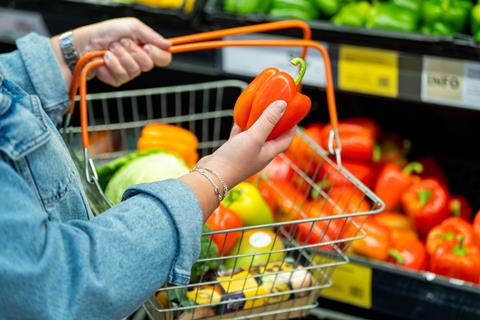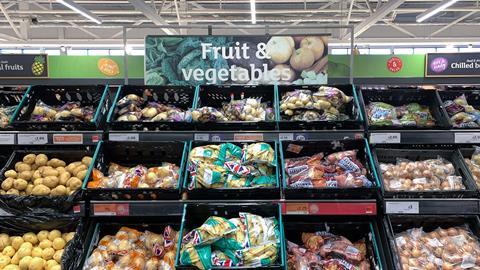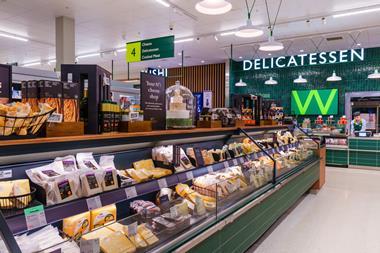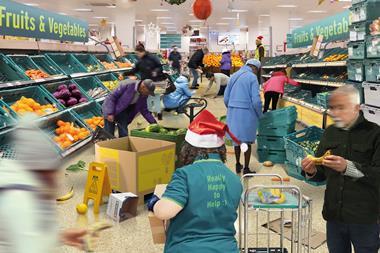Fruit & veg consumption has slumped, despite widespread awareness of the 5 a day campaign. Is a new approach needed?
In March 2003, the government launched a new 5 a day campaign, encouraging people to increase their consumption of fruit & veg and reduce their risk of cardiac disease, cancer and diabetes.
The phrase has since become embedded in the nation’s psyche, with recent research showing more than 90% of shoppers are familiar with it.
Yet, as revealed by The Grocer last week, government figures show consumers are failing dismally to heed the call – fruit & veg consumption has slumped.
So, as the government draws up its new food strategy, is it time for a new approach?

The figures in last week’s National Diet and Nutrition Survey (NDNS) reveal that less than a fifth of adults and fewer than one in 10 children are hitting the 5 a day target, with equally poor results when it comes to consumption of fibre.
Meanwhile, despite years of reformulation strategies, huge numbers of consumers are consuming too much sugar and fat.
While some of the shift could be explained, said the DHSC’s report authors, by the timeframe of the survey (2019-2023) including the Covid pandemic, as well as changes to the methodology, it pointed out the findings came on top of several other pieces of recent research also showing the same worrying trends.
The findings come at a time when public health strategy is at a crossroads, as talks on the new food strategy, involving industry leaders, NGOs and ministers, look at possible interventions.
Missing targets: the key findings
- Children aged 11-18 ate an average 2.8 portions of fruit & vegetables a day. Fewer than one in 10 children ate five portions a day.
- Adults ate between 3.3 and 3.7 portions a day. Only one in five ate five a day.
- Saturated fats provided 12.5% of energy for children aged 18 months to 18 years, and 12.6% for adults. Overall, 85% of children and 82% of adults did not meet the recommended 10% of energy from saturated fats.
- Only 9% of children and 19% of adults met the recommended maximum 5% of energy from free sugars. Average intakes were 10.5% for children and 10% for adults. Girls aged 11-18 years had the highest free sugar intake: 12%.
- Of children aged 18 months to three years, 78% did not meet fibre intake recommendations (at least 30g a day for adults and 15 to 25g a day for children dependent on age). Of those aged four to 10, 86% did not meet it. Among 11-18s the figure rose to 96%.
Source: NDNS survey 2019-23, DHSC

Mandatory reporting
The industry appears to be uniting around calls for the government to introduce mandatory reporting on the healthiness of products for supermarkets and food companies across the supply chain, with the FDF making a remarkable u-turn this week to swing behind the plans.
However, the FDF says the NDNS figures also suggest the government needs to consider shaking up the front-of-pack health labelling system and launching a major consumer-facing healthy eating drive.

“If you look at the findings, we are not meeting our guidelines and it’s been like that for a long time,” says FDF chief scientific officer Kate Halliwell.
“The survey poses big questions. How do we make those foods that contribute to fibre and fruit & veg intake more accessible?
“It’s not just about increasing access to fresh foods. How do we get more fruit and fibre from tinned foods, ready meals or bread?
Halliwell claims the government’s front-of-pack traffic light labelling system, which came into force in 2013, is another area that may need to be rethought or supplemented.
“The benefit of 5 a day is that it is very simple and easy to understand. But can we do more to help people understand what foods help them to meet this target? I think it’s possible to have a healthy choice logo or some sort of health flash on products.
“It would have to be a government scheme for it to have credibility. But if the government was to launch a campaign, then I think it would get a lot of support from industry.”
Read more:
-
FDF swings behind mandatory health reporting in call for ‘bold’ action on obesity
-
Rethinking 5 a day: a new food strategy demands a nutrient-first mindset
The previous government considered a shake-up of front-of-pack labelling but it came to nothing, while the Tories also slashed other funding encouraging kids to have healthier diets. The Change4Life programme ran for 11 years from 2009, before funding was axed.
However, last week’s figures show winding down Change4Life and its TV ads coincided with a fall in people achieving the fruit & veg target.

Lack of improvement
The British Nutrition Foundation, one of the bodies that backs mandatory reporting, says the survey results show there has been no real improvement in UK dietary patterns for two decades.
“Both the [average] number of portions and the proportion of people meeting the 5 a day recommendation are lower than in previous surveys for adults and children aged 11-18 years,” says British Nutrition Foundation science director Sara Stanner.
Stanner says a number of retailers are already trying to make it easier for people to eat more fruit & veg, such as Tesco with its Fruit & Veg in Schools campaign, as part of its wider Stronger Starts programme.
Lidl is striving to significantly increase sales of fibre-rich and wholegrain foods, beans and vegetables, through targets set this year.
Aldi has a nationwide programme to teach children aged five to 14 about eating healthily, dubbed ‘Get Set to Eat Fresh’, and run in partnership with Team GB and ParalympicsGB.
Dan Parker, CEO of Veg Power – which launched Attack the Snack, its latest campaign to encourage children to eat more fruit & veg last week – says the figures should be a “vital wake-up call” for the government.
“Our government is currently planning a national food strategy, reviewing the school curriculum, expanding access to free school meals, and grappling with the complex challenge of reversing both adult and childhood obesity – a burden that places immense strain on UK productivity and drives escalating costs in health and social care,” he says.
“They must reimagine food as a central pillar at the very heart of our education system.”
Niamh Brannelly, head of nutrition and science communication at Danone UK & Ireland, says the survey shows the “urgent need” for a new wave of reformulation across the industry.
“As an industry we have a clear role to play in improving the nation’s health.
“There is a pressing need to reformulate products to reduce sugar, saturated fat, and salt while increasing fibre and nutrient density, as well as using clear labelling and responsible marketing to support informed choices.
“Mandatory reporting could be a catalyst for reformulation and innovation.”
“Danone would be supportive of a national campaign that builds on the success of previous public health efforts like Change4Life and Better Health Start for Life. Any campaign would need to be government led and industry supported.
“There is an opportunity for the government to lead a strong and consistent public health campaign over time, in conjunction with industry, focussing on increased consumption of fruit, vegetables, nuts and seeds as well increasing intake of fibre.”
Read more:
-
The UK’s fruit & veg crisis: it’s time to prioritise food education
-
Can the UK food industry really reverse the obesity crisis?
-
Kids’ snacking: Where health meets fun
Despite the falling number of people heeding the 5 a day rule, it would be a mistake for the government to replace the campaign with something new, says Phil Gowland, commercial director at Whitworths. It should instead capitalise on awareness of the slogan by re-enforcing it through its food strategy, he says.
“We carried out a survey last year which showed 92% awareness of 5 a day among customers. Replacing that could take years with no guarantee of success. We need to go back to the reason it existed in the first place. It was because the science around low fruit and low vitamin intake was so strong.
“The same applies now. The benefit of more fruit & veg, and increased fibre intake, needs to be a key part of the food strategy. And indeed they were a major part of the recommendations by Henry Dimbleby in his strategy. The government needs to pick that up and act on it.”
While calls from the industry have centred on reporting of healthier food sales, rather than targets, there is a gathering consensus that the status quo will no longer do, with last week’s figures just the latest to reflect badly on both the food sector and policymakers.
But with the 5 a day slogan so well-recognised, progress may also lie in reminding consumers why it matters – and thus why they ought to embrace some targets of their own.




















No comments yet